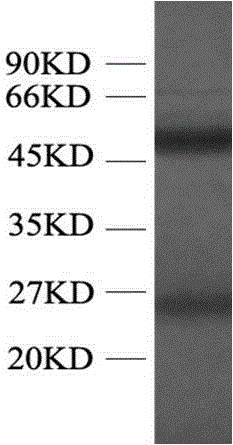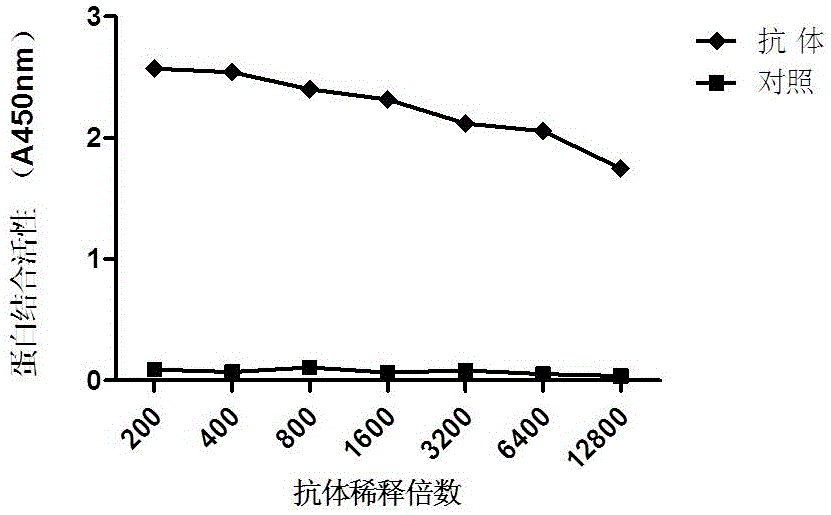Mouse anti-human P53 monoclonal antibody and hybridoma cell strain capable of secreting monoclonal antibody
A technology of hybridoma cell line and monoclonal antibody, applied in the field of bioengineering
- Summary
- Abstract
- Description
- Claims
- Application Information
AI Technical Summary
Problems solved by technology
Method used
Image
Examples
Embodiment 1
[0021] Example 1: Obtaining of hybridoma cell line 6C4 and the monoclonal antibody it produces
[0022] 1. Antigen preparation
[0023] (1) Obtain the target gene
[0024] In this example, according to the coding frame of the P53 gene sequence (BC003596.1), design a pair of specific primers:
[0025] Primer 1: 5'-CGCGGATCCATGGAGGAGCCGCAGTCAG-3' (SEQ ID NO: 1)
[0026] Primer 2: 5'-CCGCTCGAGGGCCCTTCTGTCTTGAACATG-3'; (SEQ ID NO:2)
[0027] Trizol Reagent reagent was used to extract total RNA from human adipose tissue, the total RNA was reverse transcribed into cDNA, and the P53 gene was amplified by PCR using cDNA as a template.
[0028] (2) Construction of recombinant expression vector
[0029] The PCR product obtained in step (1) was double digested and recovered, and ligated into the expression vector PET28a under the action of T4 DNA ligase to construct the recombinant plasmid PET28a-P53.
[0030] (3) Obtain expression strains containing recombinant expression plasmids ...
Embodiment 2
[0051] Example 2: Identification and Application of Monoclonal Antibody
[0052] 1. Identification of mouse anti-P53 monoclonal antibody
[0053] Cleavage and extract cos-7 cell lysate, load the sample into 10% SDS-PAGE gel wells, 20 μg / well, transfer the protein in the gel to PVDF membrane after electrophoresis, after blocking, perform immunostaining with anti-P53 antibody , add the P53 monoclonal antibody prepared and purified in step (3) of Example 1, the working concentration is set to 1:40000, overnight at 4°C, add HRP-labeled goat anti-mouse antibody, the working concentration is 1:5000, react at 37°C for 1h , resulting in a band with a molecular weight of 55KDa (see image 3 ), which is consistent with the literature reports, proving that this antibody is a specific antibody against P53; the picture shows that the band is still clear after the antibody is diluted at 1:40000, which proves that the monoclonal antibody has a very high titer.
[0054] 2. Application detec...
Embodiment 3
[0070] Example 3: Sequencing of variable regions of monoclonal antibodies
[0071] Synthesize the following primers based on the constant region sequence of the antibody gene:
[0072] zh08 5'-GGGGATATCCACCATGRACTTCGGGYTGAGCTKGGTTTT-3' (SEQ ID NO: 3)
[0073] zhr11 5'-GACHGATGGGGSTGTYGTGCTAGCTGNRGAGACDGTGA-3' (SEQ ID NO: 4)
[0074] zl01 5'-GGGGATATCCACCATGGAGACAGACACACTCCTGCTAT-3' (SEQ ID NO:5)
[0075] zlr05 5'-GGATACAGTTGGTGCAGTCGACTTACGTTTKATTTCCARCTT-3' (SEQ ID NO: 6)
[0076] Trizol Reagent reagent extracts 5×10 6 The total RNA of hybridoma cell 6C4 was reverse transcribed into cDNA. Use zh08 and zhr11 as primers to amplify the variable region of the heavy chain of the monoclonal antibody P53 by PCR, and use zl01 and zlr05 as primers to amplify the variable region of the light chain of the monoclonal antibody P53 by PCR. The PCR reactions all adopt hot start, and the reaction conditions are: 94°C for 5 minutes; 94°C for 45 seconds, 60°C for 45 seconds, 72°C for 1 mi...
PUM
 Login to view more
Login to view more Abstract
Description
Claims
Application Information
 Login to view more
Login to view more - R&D Engineer
- R&D Manager
- IP Professional
- Industry Leading Data Capabilities
- Powerful AI technology
- Patent DNA Extraction
Browse by: Latest US Patents, China's latest patents, Technical Efficacy Thesaurus, Application Domain, Technology Topic.
© 2024 PatSnap. All rights reserved.Legal|Privacy policy|Modern Slavery Act Transparency Statement|Sitemap



